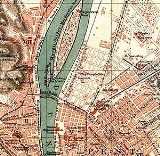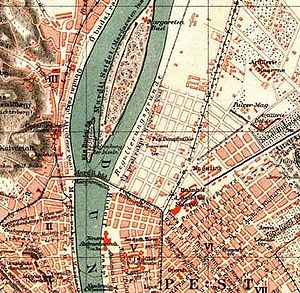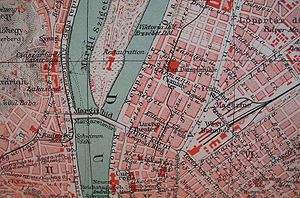
Újlipótváros
Encyclopedia
Újlipótváros is a neighborhood in the 13th district
of Budapest
, Hungary
. It is located to the north of Budapest city centre
, with the Szent István Boulevard
(Szent István körút) separating it from its southern neighbor, Lipótváros
. It lies east of the river Danube
, west of Terézváros, and south of Vizafogó. Unlike most other neighborhoods in the 13th district, Újlipótváros is considered part of the Budapest city center.

 Previously an industrial area, it was rebuilt as a residential district from the late 1920s. Almost all of the building
Previously an industrial area, it was rebuilt as a residential district from the late 1920s. Almost all of the building
s were built between 1927 and 1944. This makes Újlipótváros quite different from the other parts of the inner city
, which were mainly built before World War I
, mostly in the last three decades of the nineteenth century. The very first buildings of Újlipótváros (the so-called "Palatinus houses") are notable exceptions, these were built in 1910-1911, and represent an interesting mixture of art nouveau
and other contemporary styles. 1
It has been a popular middle-class/intellectual
residential district ever since it was built.
Between the wars it was especially popular among middle-class citizens of Jewish origin and this is partially true even today, according to recent sociological research. 2
The area closest to the river Danube is the most expensive, spacious and pleasant, especially the buildings around Szent István park, which is located on the riverside. Some of these buildings (especially the so-called "Dunapark houses") are regarded by many as one of the best examples of modernist architecture in Hungary.
", though this is not precise (the inner parts of the district are very densely built-up, and this was sharply criticized by Bauhaus architects in the thirties as pseudo-modernist architecture, with buildings featuring modernist-like facades, but bad structure), it is true that in this district one can find perhaps the best display of modern Hungarian architecture.
Some of the building stock and the infrastructure
has been renovated in the last fifteen years, including Szent István park.
The district has quite serious problems with parking
and over-crowdedness, especially in the narrower streets of its inner parts.
Its main street is Pozsonyi út, a tree
-lined street
close to the river
with a lot of restaurants, bookstores and shops.
District
Districts are a type of administrative division, in some countries managed by a local government. They vary greatly in size, spanning entire regions or counties, several municipalities, or subdivisions of municipalities.-Austria:...
of Budapest
Budapest
Budapest is the capital of Hungary. As the largest city of Hungary, it is the country's principal political, cultural, commercial, industrial, and transportation centre. In 2011, Budapest had 1,733,685 inhabitants, down from its 1989 peak of 2,113,645 due to suburbanization. The Budapest Commuter...
, Hungary
Hungary
Hungary , officially the Republic of Hungary , is a landlocked country in Central Europe. It is situated in the Carpathian Basin and is bordered by Slovakia to the north, Ukraine and Romania to the east, Serbia and Croatia to the south, Slovenia to the southwest and Austria to the west. The...
. It is located to the north of Budapest city centre
Inner City (Budapest)
Inner City is part of the historic old town of Pest. Today it is a part of the 5th District of Budapest, Hungary. Budapest's main shopping street, Váci utca , is located there, as is a large part of the city's commercial life, banks and travel agencies...
, with the Szent István Boulevard
Grand Boulevard (Budapest)
Nagykörút or Grand Boulevard is one of the most central and busiest parts of Budapest, a major thoroughfare built by 1896, Hungary's Millennium. It forms a semicircle connecting two bridges of the Danube, Margaret Bridge on the north and Petőfi Bridge on the south...
(Szent István körút) separating it from its southern neighbor, Lipótváros
Lipótváros
Lipótváros is a traditional neighbourhood in the city centre of Budapest, Hungary. It comprises the northern part of District V , north of the Belváros. Lipótváros was established in the early 19th century, and became the political centre of Hungary in the early 20th century when the Hungarian...
. It lies east of the river Danube
Danube
The Danube is a river in the Central Europe and the Europe's second longest river after the Volga. It is classified as an international waterway....
, west of Terézváros, and south of Vizafogó. Unlike most other neighborhoods in the 13th district, Újlipótváros is considered part of the Budapest city center.
History


Building
In architecture, construction, engineering, real estate development and technology the word building may refer to one of the following:...
s were built between 1927 and 1944. This makes Újlipótváros quite different from the other parts of the inner city
Inner city
The inner city is the central area of a major city or metropolis. In the United States, Canada, United Kingdom and Ireland, the term is often applied to the lower-income residential districts in the city centre and nearby areas...
, which were mainly built before World War I
World War I
World War I , which was predominantly called the World War or the Great War from its occurrence until 1939, and the First World War or World War I thereafter, was a major war centred in Europe that began on 28 July 1914 and lasted until 11 November 1918...
, mostly in the last three decades of the nineteenth century. The very first buildings of Újlipótváros (the so-called "Palatinus houses") are notable exceptions, these were built in 1910-1911, and represent an interesting mixture of art nouveau
Art Nouveau
Art Nouveau is an international philosophy and style of art, architecture and applied art—especially the decorative arts—that were most popular during 1890–1910. The name "Art Nouveau" is French for "new art"...
and other contemporary styles. 1
It has been a popular middle-class/intellectual
Intellectual
An intellectual is a person who uses intelligence and critical or analytical reasoning in either a professional or a personal capacity.- Terminology and endeavours :"Intellectual" can denote four types of persons:...
residential district ever since it was built.
Between the wars it was especially popular among middle-class citizens of Jewish origin and this is partially true even today, according to recent sociological research. 2
The area closest to the river Danube is the most expensive, spacious and pleasant, especially the buildings around Szent István park, which is located on the riverside. Some of these buildings (especially the so-called "Dunapark houses") are regarded by many as one of the best examples of modernist architecture in Hungary.
Bauhaus in Budapest
The style of the district is often described as "BauhausBauhaus
', commonly known simply as Bauhaus, was a school in Germany that combined crafts and the fine arts, and was famous for the approach to design that it publicized and taught. It operated from 1919 to 1933. At that time the German term stood for "School of Building".The Bauhaus school was founded by...
", though this is not precise (the inner parts of the district are very densely built-up, and this was sharply criticized by Bauhaus architects in the thirties as pseudo-modernist architecture, with buildings featuring modernist-like facades, but bad structure), it is true that in this district one can find perhaps the best display of modern Hungarian architecture.
Some of the building stock and the infrastructure
Infrastructure
Infrastructure is basic physical and organizational structures needed for the operation of a society or enterprise, or the services and facilities necessary for an economy to function...
has been renovated in the last fifteen years, including Szent István park.
The district has quite serious problems with parking
Parking
Parking is the act of stopping a vehicle and leaving it unoccupied for more than a brief time. Parking on one or both sides of a road is commonly permitted, though often with restrictions...
and over-crowdedness, especially in the narrower streets of its inner parts.
Its main street is Pozsonyi út, a tree
Tree
A tree is a perennial woody plant. It is most often defined as a woody plant that has many secondary branches supported clear of the ground on a single main stem or trunk with clear apical dominance. A minimum height specification at maturity is cited by some authors, varying from 3 m to...
-lined street
Street
A street is a paved public thoroughfare in a built environment. It is a public parcel of land adjoining buildings in an urban context, on which people may freely assemble, interact, and move about. A street can be as simple as a level patch of dirt, but is more often paved with a hard, durable...
close to the river
River
A river is a natural watercourse, usually freshwater, flowing towards an ocean, a lake, a sea, or another river. In a few cases, a river simply flows into the ground or dries up completely before reaching another body of water. Small rivers may also be called by several other names, including...
with a lot of restaurants, bookstores and shops.
See also
- Bauhaus in BudapestBauhaus in BudapestBauhaus was a dominant architectural tendency in Budapest, the capital of Hungary, between 1930 and 1948. Large residential buildings, cinemas, churches and even an airport was built in this style, in particular in Újlipótváros in the XIII district, and Városmajor and Pasarét in the II district of...

